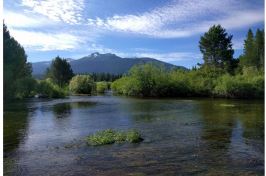 New research article featuring local ACCG member, Helen Loffland. Read the full report here: Campos_et al_ bird response to meadow restoration
New research article featuring local ACCG member, Helen Loffland. Read the full report here: Campos_et al_ bird response to meadow restoration
Montane riparian meadows foster biodiversity and support critical ecosystem services. A history of exploitation has left most riparian meadows throughout the Mountain West of the United States with incised channels, severely compromising their functionality. Hydrologic restoration of riparian meadows aims to increase overbank flow during spring run-off and elevate groundwater levels in the dry season. Outcome-based evaluations of the dominant meadow restoration methods are lacking and needed to ensure objectives are being met and to guide modifications where needed. We completed 1,282 point count surveys from 2009 to 2017 at 173 sampling locations across 31 montane riparian meadows in California restored using partial channel fill techniques (e.g. pond-and-plug) to evaluate the expected outcome of increased abundance of meadow birds. We analyzed trends in abundance for 12 focal bird species from 1 to 18 years after hydrologic restoration, substituting space for time in our mixed effects Poisson regression models that included covariates for the amount of riparian deciduous vegetation (RDV) before restoration, stream flow, precipitation, and temperature. We found evidence for a positive effect of time since restoration on abundance for 6 of the 12 species. Although pre-restoration RDV cover was the most frequently supported predictor of abundance, high pre-restoration cover of RDV slowed response rates for only two species, suggesting other elements of hydrologic function are also important for meadow birds. Drawing on our results, we provide suggestions for enhancing hydrologic restoration efforts in riparian meadows so that benefits may accrue more quickly to more bird species.
Read a publication brief from Point Blue here: Publication Brief – Bird response to hydrologic restoration of montane riparian meadows